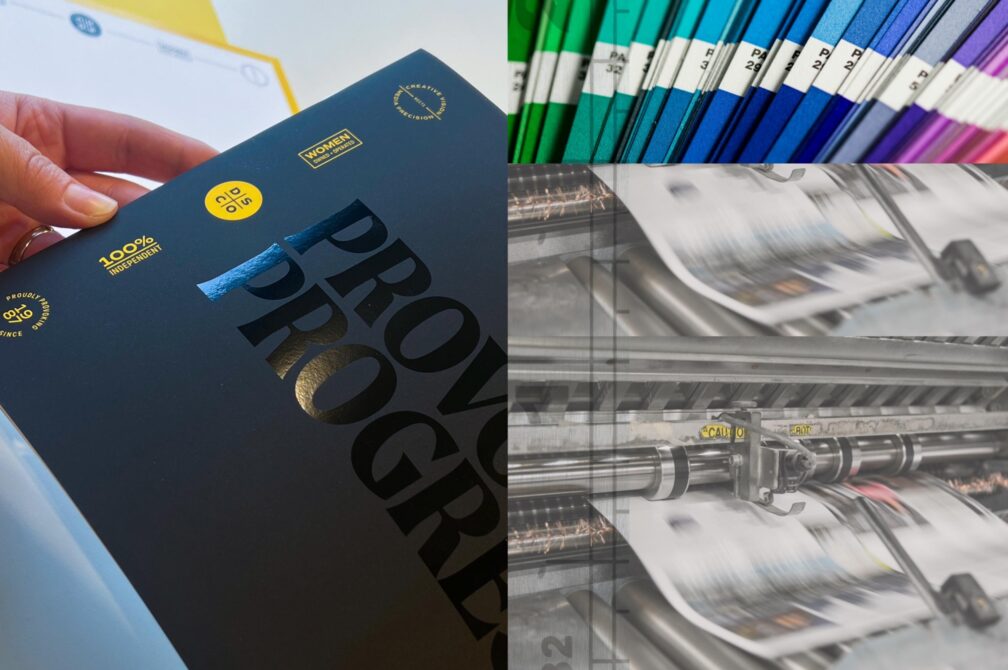Blog

Print isn’t dead (it’s a power move)
Print advertising is alive!
Everyone else thinks print is dead. A few years ago, Hodgins Engraving Co. even sent me a tongue-in-cheek casket-shaped promo saying so.
Somewhere in the social media boom of Facebook, Instagram and TikTok, an entire generation decided print is an artifact, something to be shelved next to VHS tapes and your dad’s favorite 8-tracks.
But print is very much alive. Hodgins knew that—their casket promo was part of a “Raise the Dead” campaign proving that printing and print advertising haven’t died.
Instead, they’ve adapted. They’ve evolved and morphed. Today, print is less about mass reach and more about mass impact.
Printers (and the marketers turning to them) are using a premium-feel, tactile-first approach to linger in someone’s hand and hang around the desk beyond just a fleeting moment. Pinned to a refrigerator, left on a coffee table or passed around, print has staying power that other mediums don’t.
It comes down to haptics—a word that probably makes you think of the little pulses you feel from your phone’s keyboard. But a haptic is anything related to the sense of touch. That means our brains are trained to love things we can physically feel. Paper comes from the earth, with simple ingredients: tree pulp and water. Combine those two things with a little heat and a roller, sometimes even tapping into wind power, and voilà—a product our brains can’t ignore.
Studies show that we process print differently than digital. Print leaves a deeper imprint in our memory, engages more emotional processing and boosts comprehension. A recent study in neuromarketing found that print ads generate more brain activity in areas associated with value and desire, making your brand harder to forget and easier to want.
It’s less about blanketing the market and more about laser-focused customer touchpoints backed by smart data.
Things like direct mailers with QR codes, personalized magazines and catalogs, 3D boxes and packages create a memorable user experience. Print with tactile textures, layers and quality paper hold people’s attention and create a positive brand value perception.
It might not be cheap (especially when you get Mr. or Madame Mail Carrier involved), but it is effective. Aldo Gucci once said “Quality is remembered long after price is forgotten.” That’s an important lesson in leaving a lasting, favorable impression for your brand.
It takes on average 6-8 touchpoints to make a sale. Some even say 13-20 touchpoints. Between print’s staying power and its longer life cycle, marketers are able to achieve multiple touchpoints with the same piece.
In short, print is worth the expense. And its staying power can maximize your ROI.
A few examples as proof:
Apple still runs print in major design and lifestyle magazines.
Netflix created a physical magazine just to win over Emmy voters.
Airbnb launched a print travel journal to celebrate real experiences.
Luxury fashion houses? They never stopped printing. Why? Because print is prestige.
Some key stats
- Print advertising leaves a significantly stronger and more lasting impression than digital. For example, print ads have a 77% higher brand recall rate, while digital ads average around 46%—demonstrating that people are much more likely to remember a brand they see in print than online.
- The average lifespan of a direct mail piece is 17 days.
- Additionally, print marketing boasts a response rate nearly 74% higher than digital, further highlighting its staying power.
- Campaigns that combine print and digital see up to 400% lift in effectiveness versus digital alone.
- 84% of marketers agree that direct mail provides the highest ROI of any channel they use.
The tricky part is proving that ROI. At Dixon Schwabl + Company, we use the best methods possible to connect print tactics to digital tactics. Here are a few best practices to help prove your print ROI.
QR codes
Customers can directly respond to your offering by scanning codes. If you’re using a service—like QR Tiger,
Uniqode or Bitly—these scans can be tracked.
UTMs
These snippets of code in your QR codes and weblinks allow you to track the effectiveness of your
campaign—things like traffic source, medium, campaign and more—through Google Analytics.
Custom telephone numbers
Tying an 800 number exclusively to your direct-mail campaign allows you to track call volume.
Activation codes
Like 800 numbers, activation codes specific to your direct-mail piece let you track how many codes are
being used, for which products, and whether they’re in person or online. Combine this with variable
printing for even more tracking insights.
Links to social media accounts + web pages
Be sure to include your social channels and web pages in places where you can track performance on each
platform once your target audience makes a visit.
One more time: Print isn’t dead. It’s just been waiting for us to adapt and evolve. To embrace new methods—and move forward into an era that relishes the past and embraces the future.
Bob Charboneau
Bob Charboneau is DS+CO’s Director of Print Production, finding cutting-edge solutions for his clients.